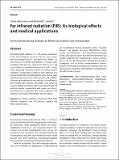Far infrared radiation (FIR): Its biological effects and medical applications
Author(s)
Vatansever, Fatma; Hamblin, Michael R.
DownloadVatansever-2012-Far infrared radiati.pdf (1.066Mb)
PUBLISHER_POLICY
Publisher Policy
Article is made available in accordance with the publisher's policy and may be subject to US copyright law. Please refer to the publisher's site for terms of use.
Terms of use
Metadata
Show full item recordAbstract
Far infrared (FIR) radiation (λ=3–100 μm) is a subdivision of the electromagnetic spectrum that has been investigated for biological effects. The goal of this review is to cover the use of a further sub-division (3–12 μm) of this waveband, that has been observed in both in vitro and in vivo studies, to stimulate cells and tissue, and is considered a promising treatment modality for certain medical conditions. Technological advances have provided new techniques for delivering FIR radiation to the human body. Specialty lamps and saunas, delivering pure FIR radiation (eliminating completely the near and mid infrared bands), have became safe, effective, and widely used sources to generate therapeutic effects. Fibers impregnated with FIR emitting ceramic nanoparticles and woven into fabrics, are being used as garments and wraps to generate FIR radiation, and attain health benefits from its effects.
Date issued
2012-10Department
Massachusetts Institute of Technology. Institute for Medical Engineering & Science; Harvard University--MIT Division of Health Sciences and TechnologyJournal
Photonics and Lasers in Medicine
Publisher
Walter de Gruyter
Citation
Vatansever, Fatma, and Michael R. Hamblin. “Far Infrared Radiation (FIR): Its Biological Effects and Medical Applications.” Photonics & Lasers in Medicine 1.4 (2012): n. pag. © 2012 by Walter de Gruyter
Version: Final published version
ISSN
2193-0643
2193-0635